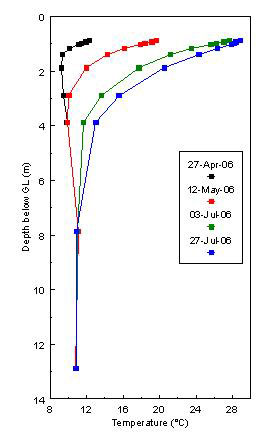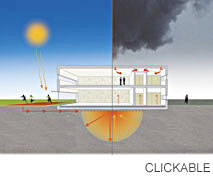Renewable Heat
Renewable heat is the generation of heat from sustainable resources. For all examples of Renewable Heat, the energy ultimately comes from the sun. The sun provides planet earth with more energy each hour than human civilization uses over a whole year. The challenge is how to make use of this vast supply of incoming radiation to provide solar space heating.
The effective use of Renewable Heat requires three keys steps:
- Capture of heat
- Storage of heat
- Release of heat
Capture of Renewable Heat
The most direct form of renewable heat capture is to collect the energy beamed down from the sun each day. All other forms of renewable heat involve the use of indirect solar heat that has been captured earlier from the power of the sun through photosynthesis, wind power or wave power. Heat can be captured directly by using roof top solar thermal panels [flat plate collectors or evacuated tubes] or through ICAX Asphalt Solar Collectors, which are designed to collect large amounts of warmth at a lower overall cost.

Storage of Renewable Heat
It is difficult to store heat energy, just as it is difficult to store electricity efficiently or cheaply. Hot water can, however, be stored effectively in insulated tanks on a small scale for a short period to bridge the time when solar heat is captured in the day to the time when heat may be needed at night for washing.
Storage of heat for an extended period has been problematic, until the recent breakthrough by ICAX which has, after an extensive period of studying the movement of heat in the ground, designed and patented Thermal Banks.
ThermalBanks are very large heat stores, normally constructed beneath the foundation of new buildings. They are designed to store a large amount of warmth over a period of months, between seasons. This breakthrough allows solar heat to be freely stored in summer, when it is surplus, until the time that it is needed for space heating in winter. Solar collectors are used to raise the temperature of the Thermal Bank in the ground from its natural temperature of 10°C to nearly 30°C over the course of the summer months.
Release of Renewable Heat
There are no technical problems in the release of hot water from insulated tanks for washing.
There are issues with the release of warmth from ThermalBanks for space heating in winter. However, these are neatly solved by using ground source heat pumps to deliver heat via underfloor heating.
A ground source heat pump is usually linked to the ground by pipe work from which it can extract a ground temperature of 10°C. It uses electricity in a compression cycle to raise the temperature of water by 30°C to 40°C, which can then be used for underfloor heating.
A heat pump in an Interseasonal Heat Transfer system is very similar except that the heat pump starts with a temperature of 25°C from the Thermal Bank, instead of just 10°C from the ground. The heat pump is twice as efficient because it has half as much work to do to raise the temperature of the water to the 40°C that is needed for underfloor heating.
Recycled Heat for Solar Heating
Interseasonal Heat Transfer from ICAX is, therefore, a new form of Recycled Heat that combines the advantages of Solar Thermal energy capture, with heat storage in Thermal Banks. This allows a heat pump to tap into stored summer sunshine in winter and double the coefficient of performance (CoP) of heat pumps: On Site Renewable Heat.
Renewable Cooling
There is a further exciting aspect of Interseasonal Heat Transfer. Having installed IHT in a new building to provide Renewable Heat in winter all the mechanism is in place for the IHT system to work in reverse and provide Renewable Cooling in summer, at a fraction of the annual running cost of using air conditioning and chillers to provide cooling. The additional capital cost of tuning underfloor piping to provide cooling, as well as heating, is marginal: however, there are further benefits in that the closer spacing of pipes enables heating to be provided at a lower delivery temperature – and a higher co-efficient of performance.
Integration and Harmony – Renewable Heat and Renewable Cooling
IHT is a straightforward system that is designed to balance the heating and cooling requirement of a building over the course of the seasons: joined-up heating. This is in contrast to the traditional approach of throwing money and fossil fuels indiscriminately at both extremes of the year, as if they were separate problems that had to be addressed by separate budgets and separate mechanisms.
IHT is an invisible heating system that requires no planning permission. We can help your building achieve a high BREEAM rating and exceed the requirements of The Merton Rule by providing Renewable Heat.
See also: IHT Systems Design
See also: Renewable Energy Directive
See also: Cash grants for domestic heat pumps
See also: Renewable Cooling
See also: District Heating using IHT
See also: Banking on IHT | The Merton Rule | Clean Energy Cashback



